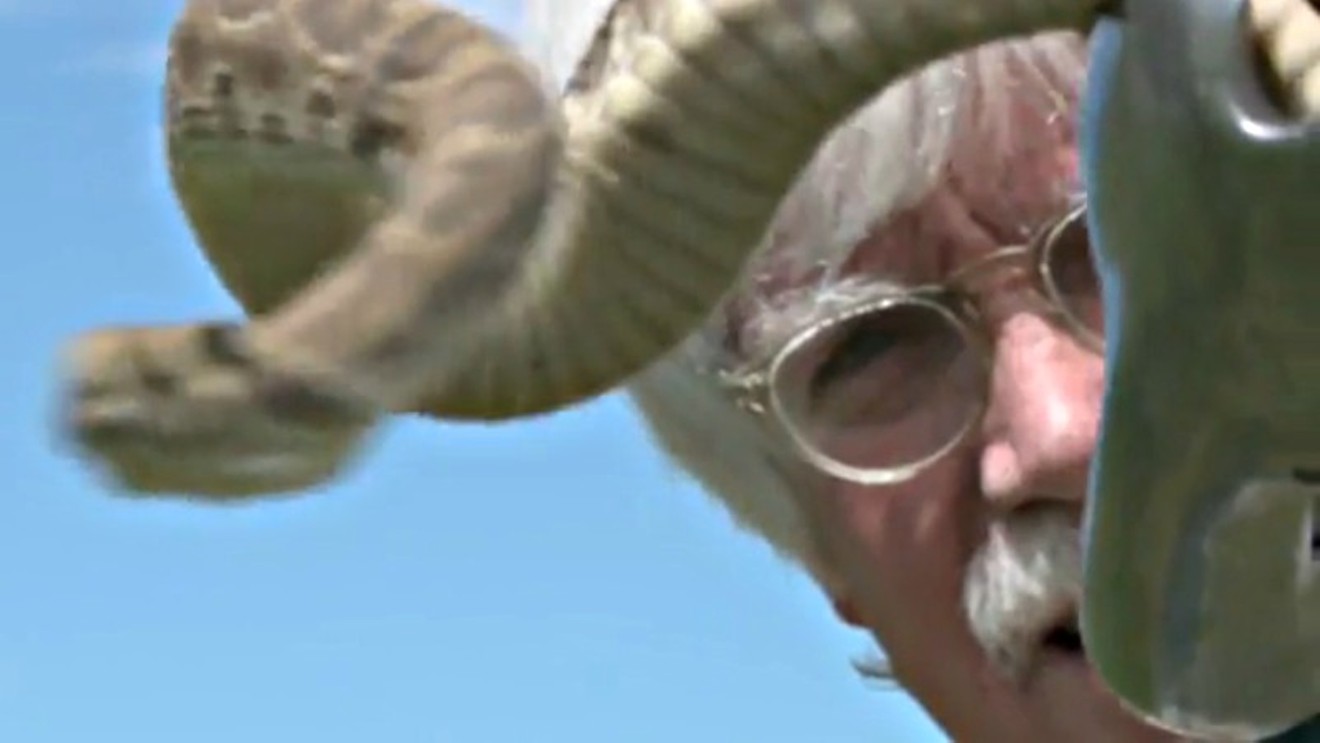Enter Dr. Kevin Fitzgerald, a veterinarian at Alameda East Veterinary Hospital as well as a star of two past Animal Planet programs, Emergency Vets and E-Vet Interns, and a regular on the Denver standup comedy scene.
His show business background aside, Fitzgerald is a serious scholar of rattlesnakes, having written or co-written numerous studies on the topic; three of them are accessible below. In addition, he has been leading a project in Jefferson County in which he implants radio transmitters in rattlesnakes to learn more about their movement and behavior.
Fitzgerald's goal is to enhance safety for humans and rattlesnakes, not to mention pets that may not survive a bite.
We asked Fitzgerald to share some of his rattlesnake knowledge, and the information he provides here is filled with fascinating factoids. Along the way, he debunks plenty of myths and offers dos and don'ts about what to do in the case of a bite. His main piece of advice: Get help from a medical professional right away, as opposed to attempting to replicate methods that work a lot better on TV shows and movies than in real life.
Oh, yeah: Fitzgerald declares rattlesnakes to be heroes. Allow him to explain that, and a whole lot more, below.

Dr. Kevin Fitzgerald and his crew taking part in the rattlesnake research project in Jefferson County.
"All snakes are deaf. They lack the circuity for hearing. But they have a part of their brain that is right on the ground, and it's really set well for vibrations, ground vibrations. So they can feel you coming."
Good Taste
"When rattlesnakes stick their tongue out, they're tasting the air. They actually taste it. They're getting particles in the air, stuff on their tongue that they can taste and smell."
Don't Look for Eggs in That Nest
"Rattlesnakes are live-bearing. They don't lay eggs. They give birth to live ones, and they have big litters — like eighteen babies. The babies stay around the den with Mom for about a week and then they split."
Don't Put Baby in a Corner
"Baby rattlesnakes have a higher concentration of active polypeptides, making the venom of the babies more toxic than the venom of the adults."
Venom Control
"A rattlesnakes' venom glands are modified salivary glands. To be venomous, you have to have a fang or a stinger, so it's different from just a poison. And these snakes can meter their venom — release as much or as little venom as they want. If they're not scared and they're just eating a field mouse, they can release just a little venom. If a dog is attacking them, they can release more venom. If someone breaks their spine, they just release everything they have."
On Track
"Venom starts digestion after the bite — so the bite is to immobilize the prey and start digesting. And rattlesnakes can follow their venom. If they bite a mouse and it gets away a few feet, they follow the trail of their own venom. They can always pick out their own venom and follow it back to the prey they've bitten."
The Eyes Have It
"Although rattlesnakes have pretty good vision, they're basically blind when they're coming through the air, because their eyes are on top of their head. But they're very in tune to motion because of the rodents and birds they eat, and even though they miss a lot of them, there are so many rodents that they're usually okay. At the Plains Conservation Center in east Aurora, there are 5,500 rodents per hectare, which is about 1,000 kilometers square, or about ten football fields. And there are at least eight or nine different kinds of rodents around: jackrabbits, cottontails, ground squirrels, prairie squirrels, field mice. There are a lot of different species of rodents in Colorado."

Dr. Kevin Fitzgerald taking a culture from a prairie rattlesnake's mouth to determine what kinds of bacteria are living there.
"Rattlesnakes are heroes because they protect us from a lot of zoonotic diseases, which are diseases we can get from animals. That includes plague, which we see in Colorado especially around prairie dogs and can get to us or our dogs and cats. I'm talking about the Black Death that killed 25 percent of Europe. They also protect us from hantavirus, which people can inhale — like inhaling the feces of infected rodents where the virus is present. That's a bad one; it causes respiratory collapse and organ failure. There's also tularemia: rabbit fever. For that one, infected animals release their urine into standing water, creeks, ponds and streams, where you can get it or your dog can, and it causes kidney failure. So rattlesnakes have a reason for being here — and they were in Colorado way before there were any people."
The Length of the Season
"Most rattlesnakes come out of their dens in late March or early April, and the latest we've had a snakebite on a dog is November 2. I think most of the snakes are back in bed by Halloween. People talk about den fidelity — the idea that snakes go back to the same dens they were born in. It's not always the same den, but it can be. And it's usually in the same general area, or pretty close. We found one den south of Greeley near Empire Reservoir outside of Wiggins that had 5,000 snakes in it. It was a big cave and had probably been used for years."
An Uncomfortable Seat
"Rattlesnakes aren't a really aggressive snake, but they're usually come upon in such a way that they're put on the defensive. The majority of bites are accidental, from people not looking where they're going when they're in tall grass or an area where they're not paying attention. We've had people sit on them before."
Danger Zones
"The majority of dogs are bitten on the face. They put their face down next to a rattlesnake and say, 'What are you?' Cats are often bitten on the foot, because they tease rattlesnakes, poke at them. The severity of the bite depends on the size of the pet. A ninety-pound dog is going to do better than a four-pound cat. And there's also the motivation of the bite. We talk about an offensive bite when they're hungry or a defensive bite when they're scared. And the amount of venom they use depends on the bite. The location of the bite is also important. I've never saved a dog bitten on the tongue or on the globe of the eye."
Helping a Dog That's Been Bitten
"A hallmark of a rattlesnake bite is tremendous swelling and tissue destruction and a lot of bruising and swelling right away — and when a dog is bitten, there's not a lot people can do in the field. Your veterinarian is as far away as a telephone. But be sure and take a picture of the snake with your phone, so we can identify which snake it is. There are a lot of garden snakes and bull snakes that bite and aren't poisonous — and you don't need to give antivenin for non-poisonous bites."
The Best Rattlesnake Myth
"The Utes, the Arapaho and the Cheyenne were all here, and they had a legend about rattlesnakes. They called them 'soft child' because of their soft bodies. Before they had their rattles and their sting, they said, the rattlesnakes went to God and told him, 'We're just little snakes, and we get stepped on by buffalo.' And God felt so bad that he gave them the rattle to warn the buffalo and the sting to protect themselves. The Indians also said that when they heard the rattles, it was like the grass was singing. That's beautiful."
Dry Is Often a Lie
"One of the myths for me is that the majority of rattlesnake bites are dry bites, where there's no venom. But don't bet on it. Some people say between 50 and 60 percent are dry bites, but I don't believe it. I think that if there's a dry bite, a series of events has to happen. They have to go through a whole sequence to release the venom, and for a dry bite, I don't think they complete that sequence. And I don't think an incomplete sequence happens as often as some people do."
What Not to Do When You're Bitten
"In the cowboy movies, you see people make an 'X' over the bite and drain it. But don't let people do that. And another myth about bites, which was written up in The Lancet, the British version of The New England Journal of Medicine, is that if you apply electrical shock to the area of the bite, it would break down the venom. It doesn't work, but a lot of people think it does. One guy was bitten in Western Colorado while hunting with his brothers, and after he was bitten on the bottom behind a tumbleweed, they applied jumper cables from a car and then turned the car on. They said he started gyrating. Suction does work, but it's very labor-intensive. There's a venom extractor made by a company called Sawyer, and you have to use it for about two hours to take 45 percent of the venom."
The Big Squeeze
"People say to put a tourniquet on the bite and it will keep the venom from spreading. But it doesn't; it concentrates it. It doesn't let the blood disperse the venom, and the area that's been bitten needs the blood supply so it can heal. By putting a tourniquet on, you stop that. So just get to a doctor right away, or get your pet to a vet."
The Bottom Line
"Let's face it: Rattlesnakes aren't really compatible with people, but they do have a place. They're part of the natural fabric of things. There are ten million forms of life on the planet, and each one, no matter how humble or inconspicuous, is a marvel of biology. And these snakes are worthy of our respect. So the challenge for the next generation is to increase the standard of living without wrecking the place. To me, the best thing would be to preserve big tracts of land where these animals live and keep it sustainable. And to have people recognize the worth of these animals."
Click to read three of Dr. Kevin Fitzgerald's scholarly studies of rattlesnakes: "Straightness of Path During and After Vernal Migration in Prairie Rattlesnakes," "Spatial Ecology of Prairie Rattlesnakes Associated With Black-Tailed Prairie Dog Colonies in Colorado" and "Additional Observations and Notes on the Natural History of the Prairie Rattlesnake."















